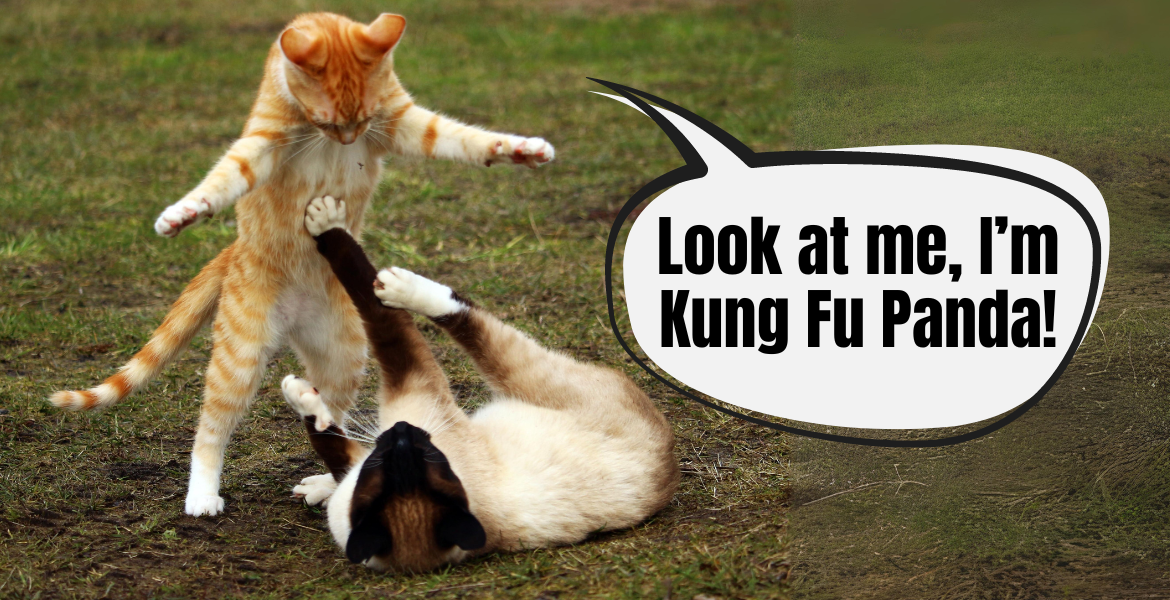Do your cats enjoy a morning wrestling match on the carpet? Or maybe they’re training together for the next Olympic Games, testing all possible cat judo moves? However you describe it, scuffles between cats can be a source of stress for many fabCats. Does this mean that the furballs have stopped getting along? Are they fighting over resources? Will it end badly? Or is this simply their way of playing and burning off energy? Today, we’ll help you explore this topic, fabCat, and show you how to read cat signals to ensure it’s still good fun and not a full-blown catfight. Stay with us 🙂
Pretend Wrestling: Paw-to-Paw Battles of Fluffy Marshmallows
Wrestling and minor scuffles are a natural form of play for cats. Even young kittens practice it, learning how to set boundaries and engage in social interactions with their siblings. Kittens love to push each other around, roll, nibble, and surprise attack, all without causing any harm. These young furballs have a blast while also learning the art of hunting. After all, their inner wild cat needs to be sure that the kitten will manage in adult life.
What happens when cats leave kittenhood and settle into their permanent home? In a place where they don’t need to hunt “for real,” defend their territory and practice all their learned hunting techniques through play? It depends on whether they end up in a single-cat household, live with a sibling, or join a home with another cat, sharing the territory. In each case, proper socialization and preparing the house to meet the needs of one or more felines will play a crucial role. Adult cats, even if neutered and from the same litter, need unrestricted access to all key resources (favorite scratching post, bed, litter box, bowls, human) to avoid feeling the need to fight over space. If neglected, their innocent scuffles can turn into a real problem. While cats can easily adapt to living in a feline group, it’s up to us, their Caregivers, to prepare their environment so they can truly get along.
Play or Serious Fight? Understanding Cat Communication
Play is extremely important in a cat’s life, whether for physical activity, expressing emotions, releasing energy, or building social bonds with other cats in the group and the hoomans. However, the most engaging and satisfying play doesn’t involve mindlessly chasing a colorful ball; high-quality play follows the so-called hunting cycle: stalking prey, chasing, and pouncing. Cats hunt this way on small creatures, but also on wand toys, feathers, or their feline buddies during friendly scuffles. Their specific body language tells us whether the “hunt” is serious or just part of afternoon fun.
How to Tell if Cats Are Playing:
- Ear Position: If they are neutral or pointed forward, rather than tense and flattened, the cat is relaxed, curious, and engaged in play, not angry or scared.
- Body Position: Relaxed, focused on play, without obvious tension or readiness for action.
- Fur: When cats play, their fur remains smooth, not puffed up. This reaction is reserved for situations where they want to genuinely scare off an opponent.
- Aggression Level: During play, cats won’t extend their claws at each other, growl, hiss, or meow loudly. These sounds are reserved for when one cat takes the play too far, and the other wants to clearly set their boundaries.
- Balance in Play: In friendly wrestling, cats will give each other equal chances and participation in the play. There’s no place for total domination by one side.
Remember: Even harmless play can turn into a fight between cats. All it takes is for one cat to get more excited than their buddy, become stressed for some reason, or simply have had enough and try to signal this to their sparring partner. It’s always a good idea to keep an eye on their body language during play and, if necessary, distract the cats by redirecting their attention, for example, to a wand toy or a favorite ball.
How to Tell if Cats Are Fighting:
- Eyes: Wide open, pupils dilated, focused on the other cat as the target of attack.
- Ears: Tense, laid back, with whiskers pointed forward and tense – a look at the cat’s face will instantly tell you they’re angry.
- Teeth: In a real fight, cats may show their teeth to more effectively scare off the opponent. They might also bite harder and scratch with razor-sharp claws.
- Tail: It will be actively involved – the cat will flick and hit the floor with it, a clear sign of feline frustration.
- Sounds: Fighting cats will yowl, moan, hiss, and growl at each other – you’ll definitely hear them.
- Fur: During a fight, the fur may be sticking out in every direction. This is called piloerection, making the cat appear bigger and more threatening to their opponent.
- Body Position: Attacking cats won’t face each other head-on. They’ll position themselves slightly sideways to have a better defensive stance and an open escape route if needed.
An important point to remember is that cats generally try to avoid fighting. They prefer to retreat rather than engage in confrontation. However, some cats, when threatened, will immediately take control of the situation and attack first, especially if they don’t see a good escape route or know that fighting is the only way to defend their territory from the opponent. If a direct clash between your cats occurs, fabCat, try to distract them to separate them and let them calm down away from each other. Also, think about how you can work on their relationship to prevent similar situations in the future – analyze the reasons that led to the fight, make changes, and for peace of mind, consult a behaviorist. A specialist will offer even more good ideas on how to ease feline conflict.
Why Do Cat Buddies Fight?
Finally, let’s check out a few common reasons why two cats who usually get along might start a domestic war. There are several, but each case should be analyzed individually to best understand the cats’ needs and choose the right method to relieve tension.
The most common reasons for catfights are:
- Inadequate Socialization: When introducing a second cat to the home, it’s important to ensure that neither the new cat nor the resident cat feels threatened by the situation. Don’t immediately allow direct contact in the hope that they’ll somehow get along – if you want lasting harmony, start with socialization through isolation and build the relationship between your cats slowly, in controlled conditions.
- Lack of Resources: Cats are territorial animals. If they feel their access to basic resources (food, hiding spots, scratching posts, toys, litter boxes) is in any way limited, they might fight with another cat over ownership. The home environment should meet the needs of the entire feline group. How to do so? Read up on the topic on our blog → https://blog.mykotty.pl/en/2023/03/27/dont-be-selfish-share-how-to-furnish-a-house-for-more-than-one-cat/
- Illness: Fights between cats who have always gotten along can signal that something is wrong with one of them. A sick cat may smell different (which won’t please the healthy cat), be in pain (and thus feel the need to defend themself from contact with another cat), be aggressive (in response to the pain), or behave like a victim, which the other cat will take advantage of.
What to Do if Your Cats Are Fighting:
If you’re sure it’s just harmless play fighting, you don’t need to do anything – the cats are just playing. However, if you notice elements of aggression or fear in their behavior, there are several things you can do to effectively separate them without causing additional, stress for you and the cats:
- Don’t Put Your Hands Between Fighting Cats: This is a recipe for disaster. Remember that both cat bites and scratches can be very dangerous – if they happen, a trip to the emergency room may be necessary.
- Don’t Scare the Cats: This is a common method, but you don’t want to add more stress, fear, and the resulting aggression to your cats. The cat won’t understand why you decided to attack them at such a stressful time. Scaring them can significantly worsen your relationship. Instead, try to use some form of barrier to place between the cats to separate them. This could be a blanket, a piece of cardboard, or even a door if you can position the cats on either side of it.
- Distract the Cats: If the fight has gone too far, this will be difficult, but if you notice the first signs of conflict between the cats, it’s always worth trying. Pull out toys, open the fridge (if the cats react to its sound), leave the room, and try to call one of the cats to you – you know best what works for your furballs. Remember that in cat duos and groups, it’s better to spend time with each cat individually than force them to play together. Ask your partner for help and have each of you play with one of the cats, preferably in different rooms. This way, they can burn off their energy without attacking each other and feeling that the other is taking a valuable resource.
- Rethink the Space: We return to this again because if the cats have started fighting, it’s important to identify the cause of their conflict. Pay attention to when disputes most often occur. Do they arise from wanting to use the same litter box? Or maybe one cat is resting on the stairs, and the other passing by makes the first cat feel unsafe. Consider building a cat highway that allows the furballs to pass each other freely. Add another litter box, more good hiding spots, sleeping places, and toys. The richer the environment, the less likely the cats are to fight.
- Talk to a Behaviorist: This is always a good plan, even if the cats only argue occasionally. You can record your cats’ behavior in conflict situations, observe the places where they most often occur, and report to the behaviorist who, with a professional eye and without bias, will assess which cat is the instigator and how to help relieve their tension.
Fighting cats is a sad sight, so we hope your furballs get along purrfectly! However, if you’ve already experienced feline conflicts, large or small, let us know how you resolved them. Perhaps your story will inspire other fabCats who are in a similar situation. We’re waiting for your stories in the comments 🙂




